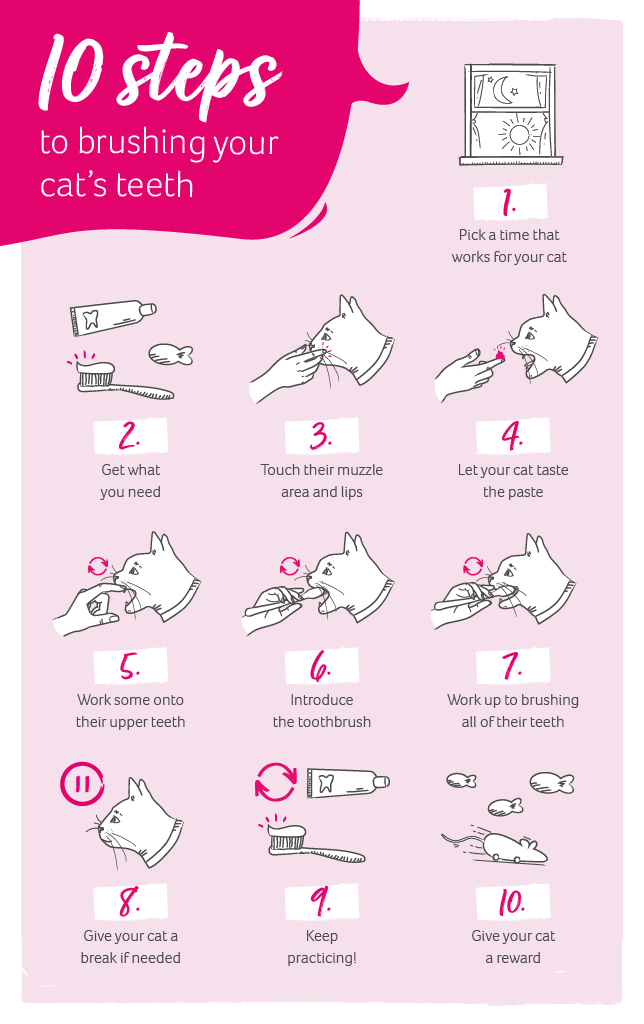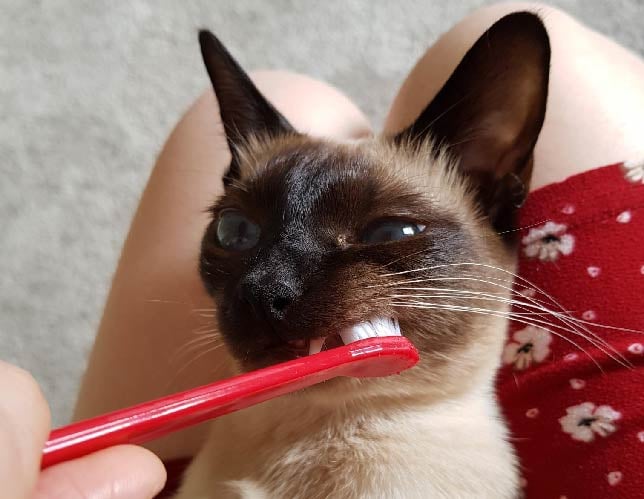How to clean your cat’s teeth
Adult cats have fewer teeth than humans do. With 30 permanent teeth, these pearly whites are key to a healthy mouth so it’s important to do your best to look after them. Getting your cat to let you take care of their teeth is another story. Here are some top tips on how to clean your cat’s gnashers.
Why do I need to clean my cat’s teeth?
Just like us, our cats need their teeth brushed routinely as it’s essential to keep them clean to prevent bad breath, gum disease, rotten teeth and dental pain. Bacteria, saliva and food particles stick to your cat’s teeth and form a film called plaque which collects in the cracks and crevices of their mouth and on the gums. If this film is left undisturbed and not brushed away, it rapidly forms rock-like brown mineral deposits known as tartar.
Unfortunately, tartar cannot be removed by brushing and will cause dental pain, loose teeth and gum inflammation which can lead to other health conditions like kidney disease.
What you need before you start brushing your cat’s teeth
- A toothbrush that’s the right size for your cat’s teeth
- Toothpaste suitable for cats (other types might be harmful)
- A reward ready for when you’re finished
- A relaxed and calming environment so that your cat will feel at ease
How to brush your cat’s teeth
If you have a kitten, start brushing their teeth as soon as you can as this will allow them to get used to it from a young age, helping keep their teeth gleaming as they grow.
If your cat is older, booking them in for a dental assessment with your vet first can help make sure any existing problems are treated before you start brushing their teeth and cause them more pain.
The timing
It is important that toothbrushing becomes part of your cat’s daily routine, so it should be performed at the same time each day, ideally when your cat is calm and quiet. If your pet is food orientated, you may want to try and do this each day before their dinner, so that they can be rewarded with their food.
As with all training, consistency is key. Ensure you give them lots of praise and attention after you have attended to their teeth and remember to always wash your hands after handling your pet’s mouth.
The reward
Pick a reward that motivates your cat! Food, treats and toys make great rewards but make sure it’s something your cat will like so that they’re more likely to behave during the task at hand.
The brushing technique
Start by getting your cat used to you touching their mouth. You could start by stroking their cheeks and working your way down. Once your cat is comfortable with you touching around the mouth area, slowly lift their lip and smear some of the flavoured cat toothpaste onto their upper teeth and gums with your finger on both sides.
The next step once your cat is happy with the finger toothpaste technique is to place a pea-sized amount of the cat toothpaste onto the special pet toothbrush. Lift the upper lip, but this time brush in small circles gently on the outside surface of the upper teeth. At first, they might not tolerate this step for very long, so you can brush a few different teeth each day. Over time you should be able to gradually build this up to brush the entire mouth in one sitting.

Remember: Only move onto the next step in the technique sequence once your cat consistently tolerates you doing the one before. This can sometimes take weeks to master so work slowly. Routine and repetition are important so making sure you do this each day will help your pet know what to expect.

Lauren from our Marketing Team is new to brushing her cat’s teeth and here's what she has to say:
“I make sure I brush my cat’s teeth at the same time each night, so it is part of her routine. I have managed to gain her trust by letting her chew a little on the toothbrush bristles, it has helped her get use to the sensation of the toothbrush while she’s technically helping me get to the harder to reach areas in the mouth! I make sure I talk to her throughout the whole process and give her plenty of praise when we have finished. It was tricky to begin with, but it does become easier with practice!”
Alternatives to brushing
While not as effective as brushing your cat’s teeth, certain alternatives can help keep their teeth and gum healthy.
- offering fruit and vegetables as snacks can help scrape food off their teeth
- cat toys filled with catnip to encourage chewing can help keep their teeth clean
- cat dental treats claim to be effective at reducing plaque and tartar
If you want more tips and tricks on cleaning your cat’s teeth, talk to the veterinary team at Joii who will be happy to advise you on the best products for your pet and help you to create a brushing routine.
Looking for more cat advice?
We’ve written some handy cat advice guides, to help you unlock the secrets of your mysterious moggy.
Need cat insurance?
Cat insurance can help cover the cost of veterinary treatment if your cat gets injured or falls ill.
